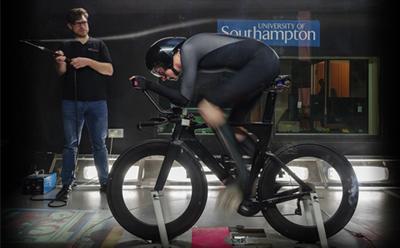Cyclists gain competitive edge with on-bike measurement of drag levels

Engineering expertise and facilities at the University of Southampton have supported the development of an on-bike drag meter that enables cyclists to improve aerodynamic performance in real time.
The Body Rocket device beams readings from the seat post, handlebars and pedals wirelessly to a cycle computer to give riders precise feedback on different positions, movements and kit.
The unique drag meter has been tested and validated at Southampton’s RJ Mitchell Wind Tunnel as part of the national SPRINT (SPace Research and Innovation Network for Technology) programme.
Dr Martyn Prince, Principal Research Engineer at the Wolfson Unit, and Professor Eric Rogers, Professor of Control Systems Theory and Design in Electronics and Computer Science, worked alongside Body Rocket founder Eric DeGolier to advance the SPRINT project.
“We were able to apply our knowledge and systems in sports-based aerodynamic testing,” Martyn says. “This allowed iterations of the Body Rocket product design to be tested and benchmarked against aerodynamic drag results measured in the controlled environment of the wind tunnel with a range of different bike setups.”
The RJ Mitchell Wind Tunnel has been at the forefront of aerodynamic research for more than 30 years. It is used extensively, not only by the performance sport industry, but also industries including automotive, aerospace and marine and maritime.
“Around 80 per cent of aerodynamic drag in cycling is created by the rider,” Eric says. “Body Rocket’s Garmin cycle computer gives you precise, real-time feedback as you experiment with different positions, movements and kit. Then, after each session you can sit down and analyse the data on our app to identify incremental improvements and answer questions like ‘what’s my optimal riding position?’ and ‘will adjusting my saddle help me go faster?’.”
Read the full story in the latest Re:action, the University’s research and enterprise magazine.